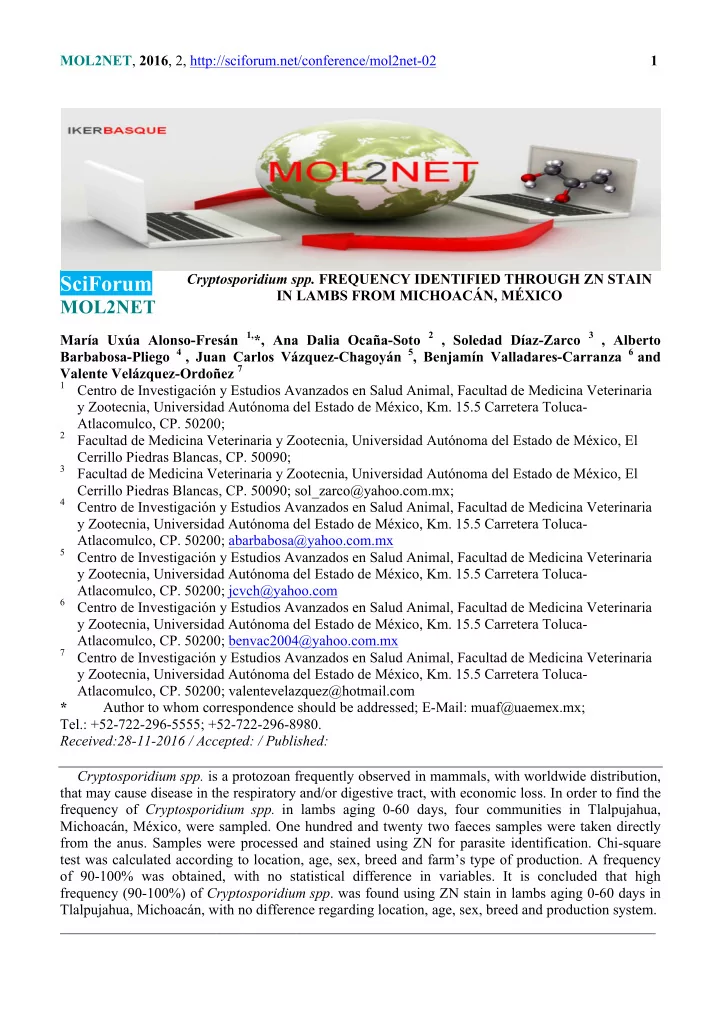

MOL2NET , 2016 , 2, http://sciforum.net/conference/mol2net-02 1 Cryptosporidium spp. FREQUENCY IDENTIFIED THROUGH ZN STAIN SciForum IN LAMBS FROM MICHOACÁN, MÉXICO MOL2NET María Uxúa Alonso-Fresán 1, *, Ana Dalia Ocaña-Soto 2 , Soledad Díaz-Zarco 3 , Alberto Barbabosa-Pliego 4 , Juan Carlos Vázquez-Chagoyán 5 , Benjamín Valladares-Carranza 6 and Valente Velázquez-Ordoñez 7 1 Centro de Investigación y Estudios Avanzados en Salud Animal, Facultad de Medicina Veterinaria y Zootecnia, Universidad Autónoma del Estado de México, Km. 15.5 Carretera Toluca- Atlacomulco, CP. 50200; 2 Facultad de Medicina Veterinaria y Zootecnia, Universidad Autónoma del Estado de México, El Cerrillo Piedras Blancas, CP. 50090; 3 Facultad de Medicina Veterinaria y Zootecnia, Universidad Autónoma del Estado de México, El Cerrillo Piedras Blancas, CP. 50090; sol_zarco@yahoo.com.mx; 4 Centro de Investigación y Estudios Avanzados en Salud Animal, Facultad de Medicina Veterinaria y Zootecnia, Universidad Autónoma del Estado de México, Km. 15.5 Carretera Toluca- Atlacomulco, CP. 50200; abarbabosa@yahoo.com.mx 5 Centro de Investigación y Estudios Avanzados en Salud Animal, Facultad de Medicina Veterinaria y Zootecnia, Universidad Autónoma del Estado de México, Km. 15.5 Carretera Toluca- Atlacomulco, CP. 50200; jcvch@yahoo.com 6 Centro de Investigación y Estudios Avanzados en Salud Animal, Facultad de Medicina Veterinaria y Zootecnia, Universidad Autónoma del Estado de México, Km. 15.5 Carretera Toluca- Atlacomulco, CP. 50200; benvac2004@yahoo.com.mx 7 Centro de Investigación y Estudios Avanzados en Salud Animal, Facultad de Medicina Veterinaria y Zootecnia, Universidad Autónoma del Estado de México, Km. 15.5 Carretera Toluca- Atlacomulco, CP. 50200; valentevelazquez@hotmail.com * Author to whom correspondence should be addressed; E-Mail: muaf@uaemex.mx; Tel.: +52-722-296-5555; +52-722-296-8980. Received:28-11-2016 / Accepted: / Published: Cryptosporidium spp. is a protozoan frequently observed in mammals, with worldwide distribution, that may cause disease in the respiratory and/or digestive tract, with economic loss. In order to find the frequency of Cryptosporidium spp. in lambs aging 0-60 days, four communities in Tlalpujahua, Michoacán, México, were sampled. One hundred and twenty two faeces samples were taken directly from the anus. Samples were processed and stained using ZN for parasite identification. Chi-square test was calculated according to location, age, sex, breed and farm’s type of production. A frequency of 90-100% was obtained, with no statistical difference in variables. It is concluded that high frequency (90-100%) of Cryptosporidium spp . was found using ZN stain in lambs aging 0-60 days in Tlalpujahua, Michoacán, with no difference regarding location, age, sex, breed and production system. __________________________________________________________________________________
MOL2NET , 2016 , 2, http://sciforum.net/conference/mol2net-02 2 Keywords: Cryptosporidium spp. ; lambs; 0-60 days; ZN stain; location, age; sex; farm’s type of production system Graphical Abstract: <<Insert a figure to summarize your work, mandatory>> Faeces samples Laboratory processing Results Interpretation of lab results . Introduction: In 1907 Tyzzer described a protozoan frequently can survive for several months. 50% Ammonia observed in lab mice, which was named and 30% formaldehyde for 30 minutes are Cryptosporidium (hidden oocysts), establishing capable of destroying Cryptosporidium oocysts its characteristics in 1910 as well as its biological (Fayer and Ungar, 1986). cycle. By 1984 it had already been identified in Four representative species were described: one 20 different species (Tzipori, 1985). It can cause isolated from mammals ( Cryptosporidium diarrhea in mammals such as beef, sheep, goats, muris ), one from birds ( Cryptosporidium horses and humans as primary agent provoking meleagridis ), one from reptiles ( Cryptosporidium intestinal and respiratory infection with croieli ) and one from fish ( Cryptosporidium important economic loss (Robertson et al. , 2014). nasorum ), when not enough information was The first human case was reported in 1976, with available. Cryptosporidium parvum was included few cases reported afterwards until it became afterwards (Clark and Sears, 1996). It was important in HIV and immunosupressed patients. thought that the parasite was species specific, Cryptosporidium are small rounded or oval until cross transmission infections were reported oocyts, with an average of 5 µm (Fayer and (Xiao, 2004). OIE Manual (2016) includes 26 Ungar 1986). It is an opportunistic organism valid Cryptosporidium species, from which C. which infects the respiratory or digestive tract or parvum , C. andersoni , C. baileyi , C. meleagridis both causing asymptomatic infections with and C. galli have caused morbility and outbreaks anorexia to depression with or without diarrhea in herds. (Tzipori, 1985). Infection occurs even with a Cryptosporidium spp. causes a self-limiting small number of oocysts. It can infect a large enterocolitis worldwide. It is common in young numbr of animals and can be found in several ruminants specially in calves and lambs, causing organs of the host, such as alveoli, bronchioles weight loss and watery diarrhea (Merck, 2007). and trachea, suggesting variable and complex Diarrhea has been observed in animals from 5 to symptoms (Zu et al., 1992). Transmission ocurrs 15 days of age, in which other pathogens such as through oral-faecal route. Oocysts excreted in rotavirus, coronavirus, Clostridium perfringens faeces are sporulated, therefore they are or enterotoxicogenic Escherichi coli may be immediately infectious. The average incubation involved, and a high mortality rate has been period is four days (Merck, 2007). Some observed in calves when extreme low experiments have shown that only 10 oocysts environmental temperature occur. Intestinal may cause infection. In large intestine, malabsorption and fluid loss due to the infection, esporozoites are released and infect the avoids the absorption of nutrients from diet epithelium where they cause diffuse moderate (Fayer and Ungar, 1986). Natural or atrophy in the villi and hyperplasia in the experimental infection show changes in the yeyunum (Zu et al., 1992). Experimental mucosa, with villi atrophy, crypt hyperplasia and infections in laboratory animals show that cellular inflammation. Diarrhea is caused by Cryptosporidium spp. is transmitted through impaired digestion provoked by membrane loss oocyst ingestion that pass from the host to the in the superior large intestine, reducing the environment (Ernest et al., 1986). Infective ileon’s absorption capacity. Some research forms are resistant to common disinfectants and studies mention that Cryptosporidium in pigs,
Recommend
More recommend